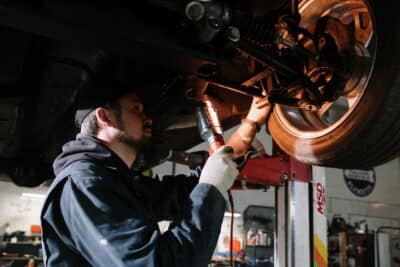The car suspension system is an intricate network of components designed to work in harmony to provide a smooth ride, maintain tire-road contact, and ensure the safety of the vehicle’s occupants.
It’s a system that often goes unnoticed until something goes wrong, but understanding its basics can help car owners appreciate the engineering marvel that keeps them comfortable on the road. In this article, we will delve into the essentials of the car suspension system and its parts.

IMAGE: PEXELS
What Is A Car Suspension System?
At its core, the car suspension system is responsible for absorbing the shocks and bumps from the road, ensuring that the car remains stable and its tires stay in contact with the ground. This not only provides comfort to the passengers but also ensures effective braking and handling, which are crucial for safety.
Key Components Of The Car Suspension System
Springs: These are perhaps the most recognized parts of the suspension system. Springs compress and expand to absorb the force of bumps. There are various types of springs used in cars, including coil springs, leaf springs, and torsion bars.
Shock Absorbers: Contrary to popular belief, shock absorbers don’t absorb shock. Instead, they control the movement of the springs and suspension. They ensure that the car’s tires remain in contact with the road. Inside a shock absorber is a piston and hydraulic fluid. When the car hits a bump, the piston moves, forcing the hydraulic fluid through small holes, which dampens the movement.
Struts: A strut combines the function of a shock absorber and a spring in one unit. It provides structural support for the car’s suspension, and its design can influence the vehicle’s handling and ride characteristics.
Control Arms: These are hinged suspension links that support the car’s wheels and allow them to move up and down. They work in tandem with the suspension bushings to ensure smooth movement.
Ball Joints: These are pivot points that allow the control arms and steering knuckles to interact. They enable the front wheels to move independently of the car’s body.
Suspension Bushings: Made of rubber or polyurethane, these parts cushion the joints and connections in the car’s suspension. They reduce friction and prevent metal-to-metal contact.
Sway Bars: Also known as anti-roll bars, they connect the left and right sides of the car’s suspension. They help in reducing the car’s body roll during sharp turns.
How Does The Car Suspension System Work?
When a car encounters a bump or a pothole, the wheel moves up or down. The spring, being compressed or extended, absorbs this movement. The energy stored in the spring is then released, causing it to bounce. The shock absorber or strut controls this bouncing, ensuring that the tire remains in contact with the road.
The control arms, ball joints, and bushings work together to allow the necessary movement while maintaining the wheel’s alignment. The sway bar, meanwhile, ensures that the car remains level during turns.
Why Is The Car Suspension System Important?
Comfort: Without an effective suspension system, every bump and imperfection on the road would be directly felt by the car’s occupants. The suspension system ensures a smoother ride.
Handling: The suspension system ensures that the tires remain in contact with the road, especially during turns, accelerations, and decelerations. This ensures that the car responds effectively to the driver’s inputs.
Safety: A well-functioning suspension system ensures that the vehicle remains stable, especially during emergency maneuvers. It also ensures effective braking, as the tires need to be in contact with the road for the brakes to work optimally.
Maintenance Of The Car Suspension System
Like all car parts, car suspension system parts wear out over time. Regular inspections can help identify worn-out parts before they lead to more significant problems. Common signs of suspension issues include uneven tire wear, excessive bouncing after hitting a bump, or a car that pulls to one side.
Conclusion
In conclusion, the car suspension system is a marvel of engineering that plays a crucial role in ensuring comfort, handling, and safety. By understanding its basic components and their functions, car owners can better appreciate the importance of regular maintenance and the signs of potential issues. Whether you’re a car enthusiast or just someone who wants a smooth ride, understanding the intricacies of the suspension car parts is invaluable.

IMAGE: PEXELS
If you are interested in even more technology-related articles and information from us here at Bit Rebels, then we have a lot to choose from.
COMMENTS